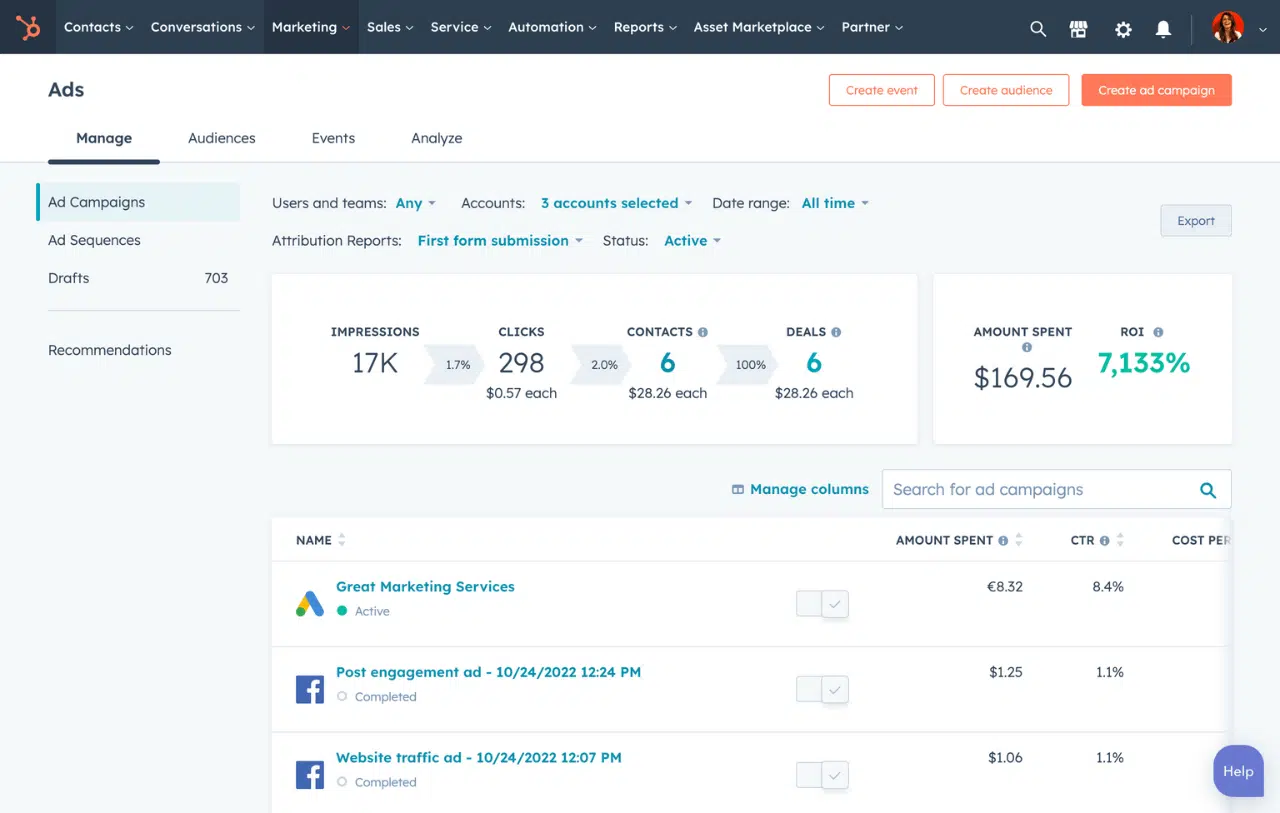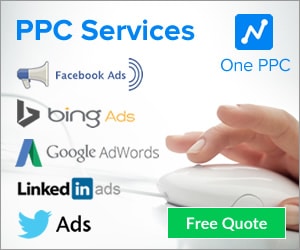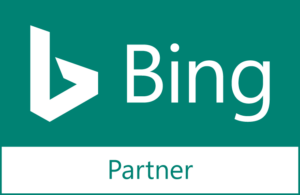As the era of Web 2.0 and third-party cookie tracking draws to a close, the landscape of “offline” conversion tracking is undergoing a transformation. The term now extends beyond simply tracking offline conversions; it encompasses online conversions that remain unrecorded due to browser limitations, privacy concerns, and ad-blocking technology.
Whether you’re a service-oriented company relying on Google Ads for lead generation or an e-commerce business dependent on sales, this blog post offers insights on leveraging cookieless tracking challenges for growth. By staying informed about evolving conversion tracking trends and adopting innovative strategies, you can optimise advertising spend for the best possible return on investment (ROI).
Table of Contents
- Current Advertising Landscape
- The Transition from 3rd Party Cookies to Web 3.0
- How does this all impact online advertising?
- Preparing for a Cookie-less World
- How Do I Record Ad Click ID's To Update Google Ads?
Current Advertising Landscape
The decline of third-party cookies signifies the advertising industry’s departure from using these cookies to monitor user online behaviour. This shift arises from concerns about user privacy, data protection, and the emergence of privacy-centric web browsing practices.
As online privacy concerns continue to grow, more and more internet users are implementing measures to block cookies and disallow mobile app ID tracking. This has resulted in a significant number of online conversions going unrecorded, which not only affects reporting accuracy but also has a substantial impact on the bidding process, which relies on accurate conversion data for machine learning.
To exacerbate matters further, Google will soon phase out all third-party tracking when they no longer support it in Google Chrome. As a result, fewer and fewer “online” conversions will actually be recorded by Google, making it essential for advertisers to find new ways to track conversions effectively to ensure they get the best advertising ROI. (The same applies to other online advertising platforms such as Facebook Ads, Microsoft Ads, LinkedIn Ads etc).
The Transition from 3rd Party Cookies to Web 3.0
The rise of Web 3.0 heralds a new internet era characterized by decentralised platforms, blockchain technology, and heightened user data control. This era promises enhanced privacy and security, while also introducing fresh opportunities and challenges for advertisers.
During Web 2.0, dominant players like Google and Facebook secured a market share exceeding 70% through third-party cookies that tracked users’ browsing activities. This enabled them to deliver precisely targeted ads based on browsing history, preferences, and interests.
However, with third-party cookies being phased out, the advertising landscape is pivoting toward privacy-focused user data collection and usage. Web 3.0’s emergence accelerates this trend by introducing technologies and platforms emphasising user data control and privacy.
How does this all impact online advertising?
One of the major impacts of the end of third-party cookies and the rise of Web 3.0 is the need for advertisers to rely more on first-party data to track user behaviour and measure campaign effectiveness. This involves building direct relationships with users and obtaining their consent for data collection and usage.
Moreover, Web 3.0 technologies such as blockchain are creating new opportunities for advertisers to engage with users in a more decentralised and secure way. This has the potential to fundamentally transform the advertising industry by offering greater transparency, accountability, and user control over data.
Overall, the shift towards more privacy-focused web browsing practices and the emergence of Web 3.0 represent a fundamental change in the way the internet operates. While this presents challenges for advertisers, it also offers an opportunity to build a more sustainable and user-centric advertising ecosystem, where privacy and security are prioritised, and users have more control over their data.
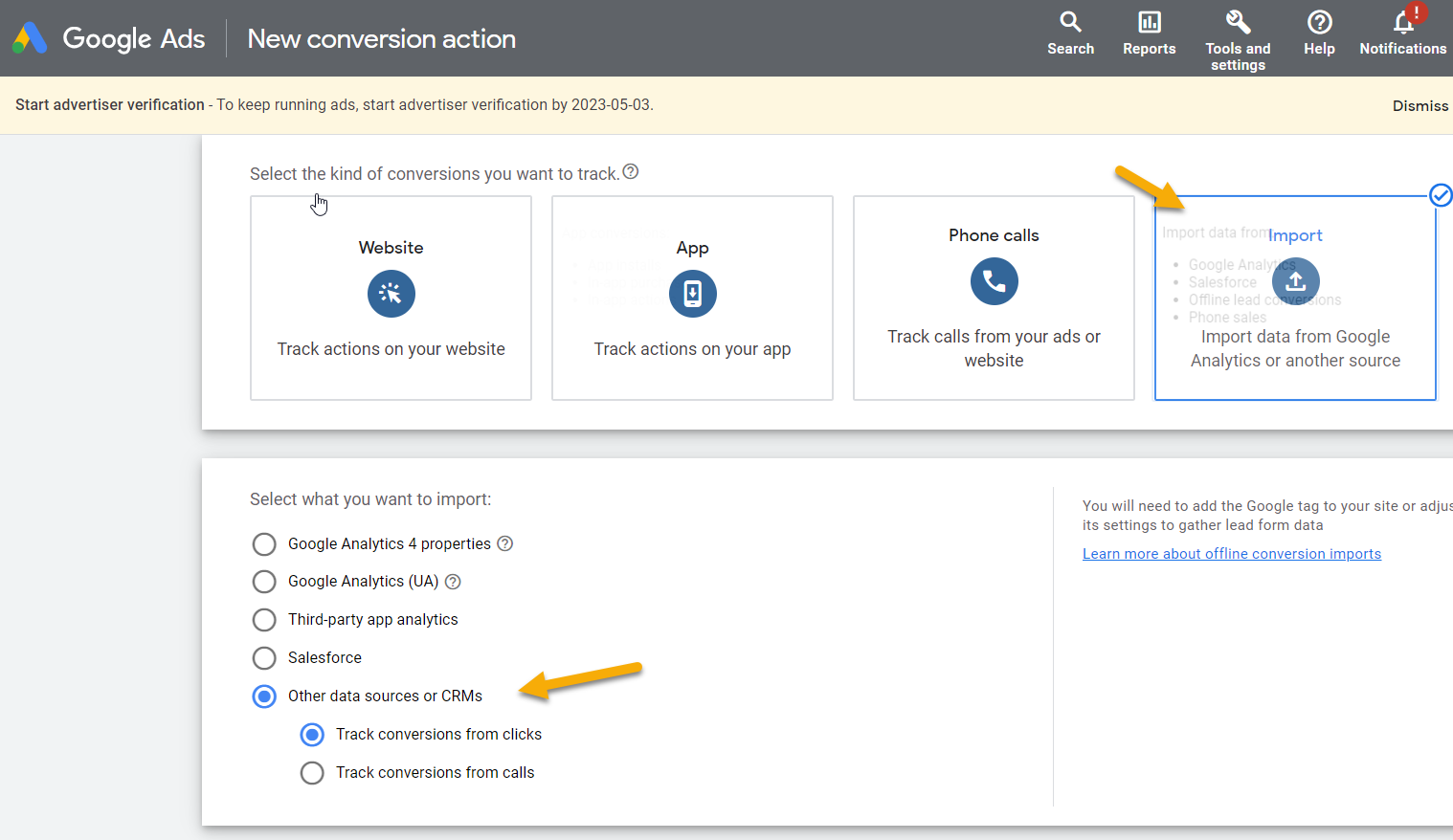
Preparing for a Cookie-less World
This transition mandates advertisers to embrace fresh conversion tracking methods such as first-party data, server-to-server tracking, and privacy-focused measurement solutions.
Remaining ahead necessitates advertisers to remain informed about conversion tracking developments and be open to novel approaches. By embracing these changes, they can persist in gauging campaign effectiveness and making data-informed choices yielding optimal outcomes.
To stay ahead of the curve, advertisers need to keep themselves informed about the latest developments in conversion tracking and be willing to explore new approaches. By embracing these changes, they can continue to measure the effectiveness of their campaigns and make data-driven decisions that lead to optimal results.
In the following sections, we will explore some of the emerging trends in conversion tracking and provide actionable insights on how advertisers can prepare to win in a cookieless future.
Read our article here to learn more about preparing for the end of third-party cookies.
Using Offline Conversion Tracking for Online
Businesses must now amass more “first-party data” to refine their advertising strategies. Integrating your website and CRM with Google Ads stands as one solution to trace unrecorded online conversions.
In a novel twist, “offline” conversion tracking—traditionally tied to monitoring offline conversions—now encompasses unrecorded online conversions arising from browser constraints and third-party tracking limitations. Instances include user cookie blocks and mobile app ID tracking refusal, causing a considerable number of online conversions to remain untracked.
Offline conversion tracking serves as a potent remedy for online conversions escaping the grasp of traditional online tracking tools or enhanced conversions. Occasionally, a user’s browser fails to retain requisite tracking cookies upon ad interaction due to browser settings, ad blockers, or other factors. Consequently, the online tracking system might inaccurately attribute conversions, yielding an incomplete depiction of campaign performance.
Offline conversion tracking empowers advertisers to leverage their CRM systems for identification and tracking. This involves matching the user’s ad click ID with contact details stored in their CRM (like name, email, or phone number). The unsynchronized conversions—both online and offline—are then fed back to Google Ads. As a result, conversions unrecorded by Google Ads can be accurately linked to the generating ad campaign.
This integration of offline conversion tracking into online campaigns furnishes advertisers with valuable insights for data-driven decision-making. By capturing offline conversions eluding conventional online tracking methods, advertisers attain a more accurate campaign impact appraisal, thus refining their strategies.
Furthermore, automated techniques such as bidding strategies thrive on robust conversion data. Offline conversion tracking furnishes advertisers with a trove of invaluable data, enhancing the precision of their bidding strategies and ultimately yielding superior advertising outcomes.
Additionally, by delivering a holistic view of the customer journey, offline conversion tracking enables advertisers to optimise campaigns
Using the Click ID to Record Conversions in CRM
To address this challenge, offline conversion tracking involves recording the click ID and timestamp of the advert clicked on, and then matching it to a conversion that occurs “offline”, such as a phone call or an in-store purchase.
You can also feed missing “online” conversions back into Google Ads that were not recorded by a third-party cookie. This is essential for accurately tracking conversions to optimise your advertising campaigns.
Click ID is a unique identifier that is generated by Google Ads when a user clicks on an ad. This ID is then used to track the user’s activity and conversion across different channels, including offline channels such as phone calls or in-store purchases.
In the context of offline conversion tracking for Google Ads, click ID plays a crucial role in recording offline conversions that occur after a user clicks on an ad. By recording the click ID, advertisers can match the user’s activity (Online and offline) to their online ad click and attribute the conversion to the ad campaign. This enables advertisers to accurately measure the performance of their ads and optimise their campaigns for better results.
However, it is important to note that click ID tracking requires the use of first-party data, as third-party cookies will no longer be supported by Google in the future. This means that advertisers must integrate their website and CRM with Google Ads to capture first-party data and track offline conversions effectively. Using tools like Zapier can help automate this process and make it easier to track offline conversions in Google Ads.
In this blog post, we will explore the complexities of cookie-less conversion tracking and how to effectively use offline conversion tracking to capture missing conversions. We will discuss the importance of tracking both “online” and “offline” conversions to optimise your advertising campaigns, and how Zapier can be used to automate the process of recording traditional “offline” conversions as well as online reconversions that were not recorded.
Using Zapier for Offline + Cookieless Conversions
In this blog post, we will explore the importance of accurately tracking conversions, both online and offline, to optimise your advertising campaigns. Specifically, we will delve into how Zapier can be used to automate the process of recording traditional “offline” conversions, as well as “online” reconversions that were previously not recorded.
With the advent of cookie-less tracking, it has become increasingly important to rely on first-party data and offline conversion tracking to gain insights into campaign performance. This requires a comprehensive understanding of both online and offline user behaviour, which can be achieved by implementing the right tools and processes.
We will discuss how Zapier, a powerful automation tool, can help you seamlessly integrate data from various sources and automate the process of recording conversions, both online and offline. By leveraging Zapier’s capabilities, you can ensure that your conversion data is accurate and up-to-date, allowing you to make data-driven decisions and optimise your campaigns for maximum ROI.
We shall provide actionable insights into the importance of tracking cookie-less conversions, and how Zapier can be leveraged to automate the process of recording conversions, both online and offline.
By following these guidelines, you can stay ahead of the curve and ensure that your advertising campaigns are optimised for success.
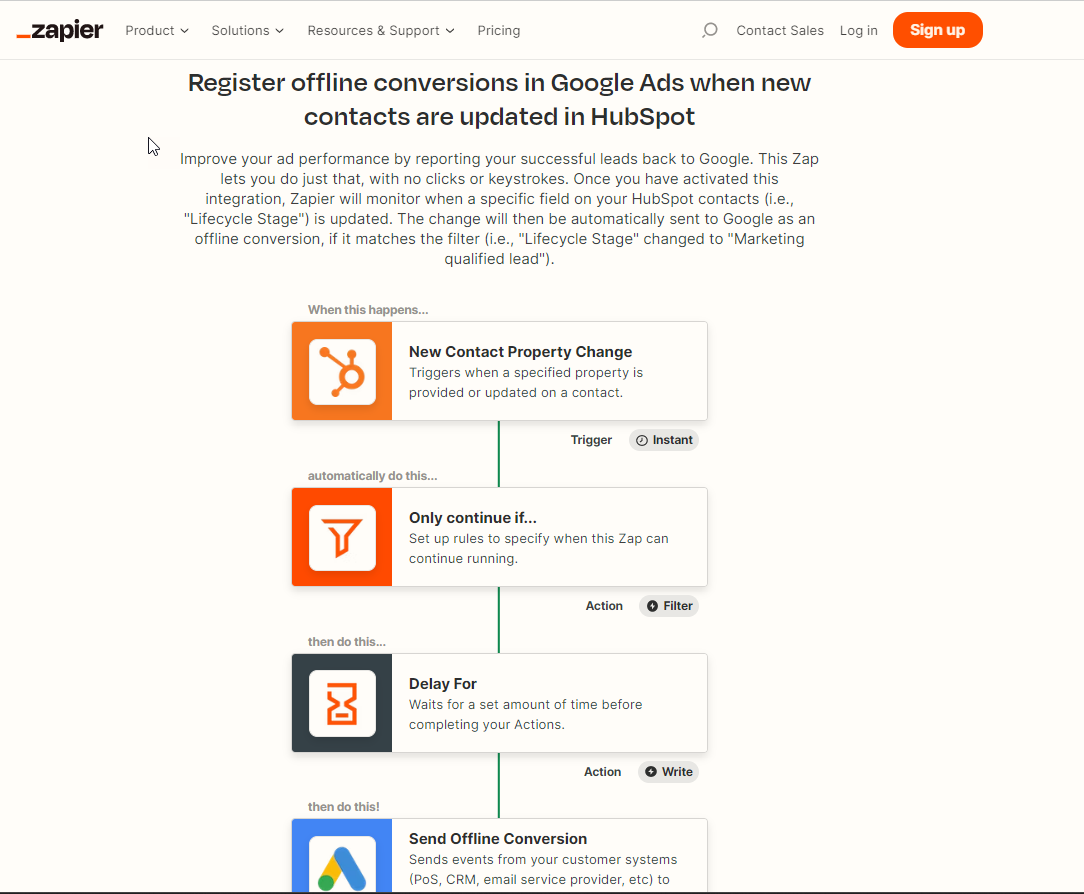
Conversion Tracking Terminology & FAQ
Before we go into depth on the topic, let’s define the terminology and functionality of the various tracking technologies – both old and new.
What is Standard Online Conversion Tracking in Google Ads?
Standard Google Ads conversion tracking is a feature that allows advertisers to track specific online actions that users take on their website after clicking on a Google Ads ad.
This can be events or key page views that signal a conversion has happened (e.g. a form redirect thank you page). So, as long as a conversion tracking script is able to capture an online conversion, standard conversion tracking records conversions (actions that happen on websites or Apps).
This feature enables advertisers to measure the effectiveness of their campaigns and optimise their bidding and targeting strategies to maximise their return on investment.
To set up standard conversion tracking, advertisers need to place a tracking code snippet generated by Google on their website. The tracking code consists of a unique conversion ID and a conversion label that identify the specific conversion action being tracked, such as a purchase, a form submission, or a phone call.
When a user clicks on an ad and performs the desired action, the tracking code sends a signal back to Google Ads, which records the conversion and attributes it to the appropriate ad and campaign. Advertisers can view conversion data in their Google Ads account, including the number of conversions, conversion rate, cost per conversion, and conversion value.
In addition, Google Ads allows advertisers to set conversion tracking goals and create conversion-based bidding strategies. For example, advertisers can set a target cost per conversion or a target return on ad spend (ROAS) and let Google Ads automatically adjust their bids to maximize conversions(leads) or revenue (sales). If you want to learn more, checkout out this blog post about standard online conversion tracking for Google Ads.
What is a Cookie?
A cookie is a small text file that is stored on a user’s device by a website. Cookies can be used for a variety of purposes, such as remembering a user’s preferences, keeping a user logged in to a website, or tracking a user’s browsing behavior for advertising purposes.
An advert click ID or email ID are alternative ways of tracking instead of using third party cookies.
What is a Click ID?
Click ID, also known as GCLID (Google Click ID), is a unique identifier that is automatically generated by Google Ads for each click on a Google ad. The Click ID is appended to the landing page URL and is used to track the user’s activity on the website after clicking the ad. This information is used by Google to attribute the conversion back to the ad and to provide advertisers with valuable insights into their advertising performance.
A click ID, also known as a tracking ID, is a unique identifier that is generated by an advertising platform when a user clicks on an ad. The click ID is then passed through to the advertiser’s website as a parameter in the URL, allowing the advertiser to track the effectiveness of their advertising campaigns by attributing clicks and conversions to specific ads.
The click ID is very useful for “offline” conversion tracking because it allows for conversions to be attributed based on the click ID and timestamp.
While click IDs and cookies can both be used for tracking purposes, they serve different functions and are implemented differently. The click ID will still exist when 3rd party cookies no longer used on the internet.
Offline conversion tracking works by importing conversion data into Google Ads from an external source, such as a CRM system. However, in the absence of third-party cookies, the Click ID is a way used to bridge the gap between online and offline conversions.

What is Customer Match in Google Ads?
Customer Match lets you use your online and offline customer data to reach and re-engage with your customers across Search, the Shopping tab, Gmail, YouTube and Display. Using information that your customers have shared with you, Customer Match will target ads to those customers and other customers like them
Customer Match is a powerful tool for advertisers that allows them to reach and re-engage with customers across various platforms. It enables advertisers to use both online and offline data to target their ads to specific customers and those who are similar to them.
With Customer Match, businesses can target their ads to individuals who have shared information with them such as email addresses, phone numbers, and physical addresses.
Customer Match is available on Google Ads, enabling advertisers to target their ads on various Google properties such as Search, the Shopping tab, Gmail, YouTube, and Display.
What is Enhanced Conversion Tracking for Google Ads?
Enhanced conversions is a powerful feature offered by Google Ads that can significantly improve the accuracy of your conversion tracking.
With enhanced conversions, your existing third party conversion tags (pixel) are supplemented with hashed first-party conversion data from your website. This data is sent to Google Ads in a privacy-safe way, without revealing any sensitive information.
Enhanced conversion tracking captures both third-party cookie data and first-party data such as email addresses entered into forms on your website or from your CRM, which helps to provide a more complete picture of your customers’ actions.
By using enhanced conversions, you can measure the true impact of your ad campaigns, better understand the behavior of your customers, and optimise your ad spend for maximum ROI. Additionally, you can use this data to create more effective and personalised marketing campaigns that are tailored to the specific needs and preferences of your customers.
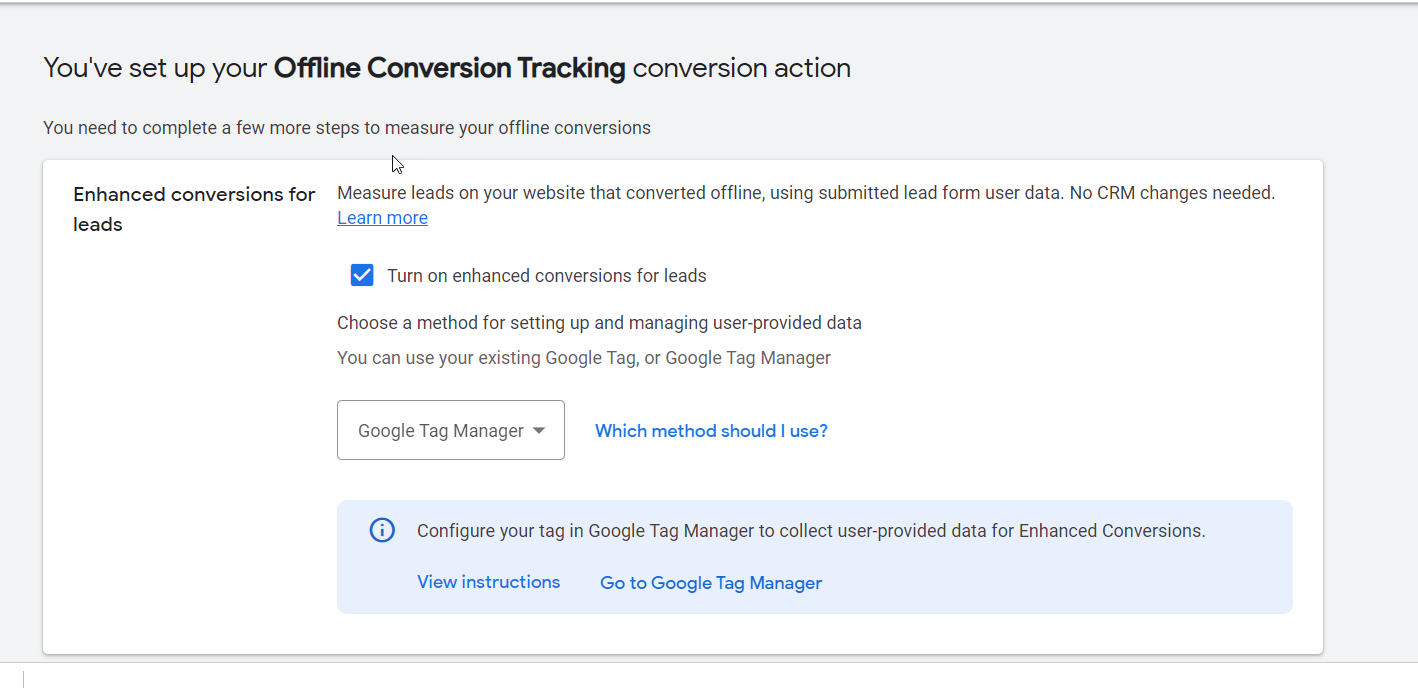
What is 1st Party Server Side Conversion Tracking?
Server-side Tag Manager is a powerful tool that allows advertisers to move their Google Ads conversion tracking tags from the webpage to the server, enabling them to record conversions as first-party data instead of relying on outdated third-party tracking cookies. This provides several benefits for advertisers, including improved data accuracy, enhanced privacy protection, and increased flexibility and control over their data
By using Server-side Tag Manager, advertisers can effectively track user behavior on their website like conversions/events, without relying on third-party cookies, which are gradually being phased out due to concerns over user privacy. This enables them to collect more accurate and reliable data on user interactions with their website, and make better-informed decisions about their advertising campaigns.
One of the key benefits of Server-side Tag Manager is that it allows advertisers to record conversions as first-party data, which provides greater privacy protection for users. This is because first-party data is subject to stricter data protection regulations, and is less vulnerable to third-party data breaches or misuse.
Overall, Server-side Tag Manager is a powerful solution for advertisers looking to adapt to the changing landscape of online advertising and protect user privacy. By moving their conversion tracking tags to the server and recording conversions as first-party data, advertisers can gain greater control over their data and improve the accuracy and effectiveness of their campaigns
What WAS "Offline" Conversion Tracking?
Offline Conversion tracking for Google Ads is a powerful tool that enables advertisers to track the effectiveness of their online advertising campaigns in driving offline conversions, such as phone calls, in-store purchases, or form submissions. This type of tracking is particularly useful for businesses that rely on phone calls or in-store visits to generate leads or sales.
To use Offline Conversion tracking, advertisers first need to upload a list of offline conversion events to Google Ads. This list can include information such as the date and time of the conversion, the customer’s contact information, and the conversion value. Once this data is uploaded, Google Ads can use it to match the offline conversions back to the corresponding online ad interactions, allowing advertisers to measure the effectiveness of their campaigns and optimise their advertising spend accordingly.
One of the key benefits of Offline Conversion tracking is that it provides a more complete view of the customer journey, from online ad impression to offline conversion. This allows advertisers to gain greater insight into how their advertising campaigns are driving real-world results, and make more informed decisions about their marketing strategies.
Overall, Offline Conversion tracking is a powerful tool for advertisers looking to maximise the effectiveness of their online advertising campaigns and gain a more complete understanding of their customers’ behavior. By tracking offline conversions and integrating this data into their online advertising campaigns, advertisers can optimise their campaigns for maximum ROI and drive real-world results for their businesses.
How Do I Record Ad Click ID's To Update Google Ads?
To use Click ID in offline conversion tracking, advertisers need to capture the Click ID when a user clicks on the ad and pass it along with the conversion data to Google Ads. This can be done in several ways:
1. Offline Conversion Import:
Google Ads provides a tool called Offline Conversion Import, which allows advertisers to upload offline conversion data to Google Ads. The tool requires advertisers to include the Click ID in the conversion data, along with other conversion details such as conversion time and value. Google Ads matches the Click ID with the corresponding click and attributes the conversion back to the ad.
2. CRM Integration:
Advertisers can integrate their CRM system with Google Ads to automatically import offline conversion data. The integration requires the CRM system to capture the Click ID when a lead or sale is generated and include it in the conversion data. The data is then sent to Google Ads using the API or another integration method.
3. Call Tracking:
Advertisers can use call tracking software to capture the Click ID when a user calls the business from the ad. The software assigns a unique phone number to the ad and captures the Click ID when a user calls that number. The Click ID is then passed along with the call data to Google Ads, allowing the advertiser to attribute the conversion back to the ad.
In summary, Click ID is used in offline conversion tracking to bridge the gap between online and offline conversions. So, by capturing the Click ID and passing it along with the conversion data, advertisers can attribute offline conversions back to the ad and gain valuable insights into their advertising performance.
This is especially important in the absence of third-party cookies, as advertisers need alternative methods to track and measure their advertising impact.

Manual Upload
While we will provide a guide for the manual approach, we do not recommend it for large datasets or when other options are available. It is much more efficient to use a software tool that can automate the process.
To record the click ID and match it with an offline conversion in Google Ads, you will first need to set up conversion tracking and an offline conversion import in your Google Ads account. Here are the steps:
A). Set up conversion tracking:
Go to the “Tools & Settings” menu in your Google Ads account, then select “Conversions”. Click the “+Conversion” button to create a new conversion action. Choose the type of conversion you want to track (e.g. phone calls or in-store purchases) and follow the prompts to set up the conversion tracking code on your website or in your app.B). Enable offline conversion imports:
In the “Conversions” section of your Google Ads account, click the “Settings” icon (gear icon) and select “Offline Conversions”. Click the “+Upload” button to create a new upload, and choose the type of conversion you want to import (e.g. phone calls or in-store purchases).1. Record the click ID:
When a user clicks on your ad, Google Ads generates a unique click ID for that click. You will need to record this click ID along with the other details of the offline conversion (e.g. transaction amount, conversion time) in a spreadsheet or other database.
2. Match the click ID
Match click ID with the offline conversion: In your spreadsheet or database, you can use the click ID to match the offline conversion with the corresponding ad click in Google Ads. To do this, you will need to include the click ID as a column in your offline conversion data, and then upload the data to Google Ads using the “Offline Conversions” section of your account.
3. Check your conversions:
After you upload your offline conversion data, Google Ads will attempt to match the offline conversions with the corresponding ad clicks using the click ID. You can view the results of the matching process in the “Conversions” section of your Google Ads account.
Note that there may be some limitations to the types of conversions you can track using offline conversion tracking, and you will need to ensure that you are following Google’s policies regarding data privacy and security. It’s also important to regularly check and update your offline conversion data to ensure that it is accurate and up-to-date.
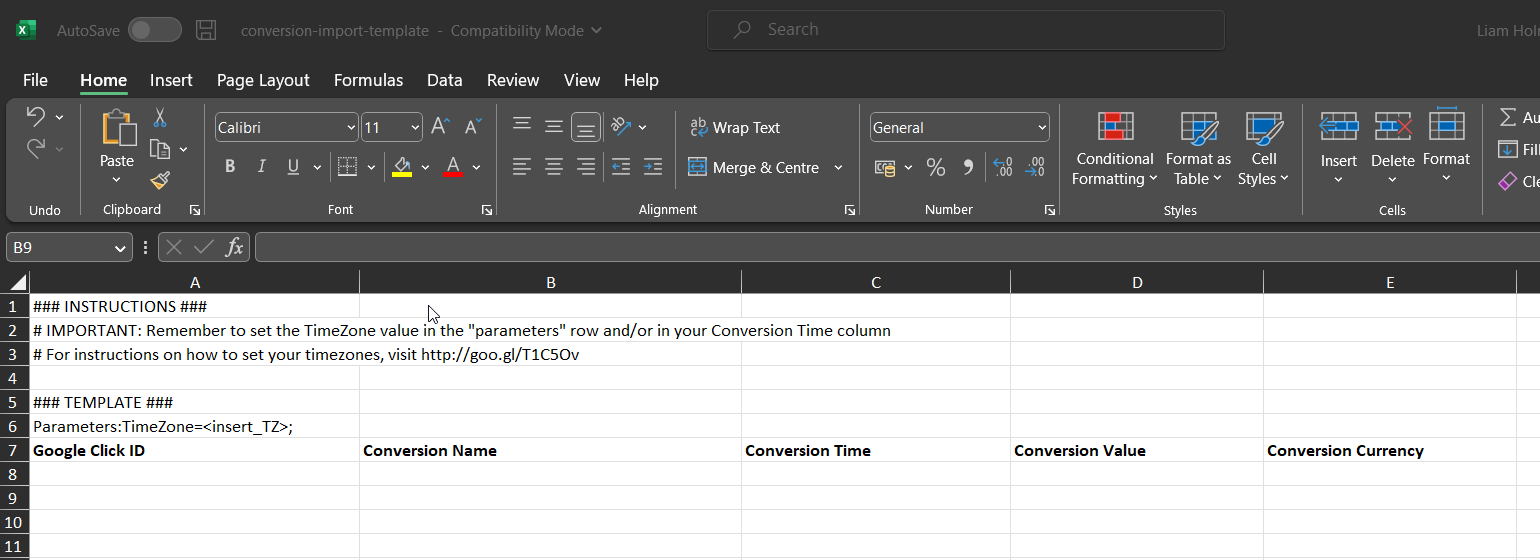
Automatic Upload
A few CRM systems offer seamless integration with Google Ads’ offline conversion tracking, simplifying the process of tracking leads and conversions. To get started, you’ll need to create offline conversion tags in Google Ads and configure ad lead lifecycle events in your CRM. From there, the integration process is automatic, taking care of the rest.
The two most prominent CRM systems with out-of-the-box integration are HubSpot and Salesforce. You can learn more here: www.hubspot.com/google-Ads and www,salesforce.com/google-ads
If your business uses a different CRM, Zapier offers another option for integration with Google Ads. It’s worth checking if your CRM is among the list of supported integrations and, if it is, you can use pre-built Zaps or workflows to integrate your sales cycle or buyer funnel with Google Ads.
Google specifically recommends using Zapier for offline conversion tracking, so it’s a reliable solution to consider. With a supported CRM and Zapier’s pre-built workflows, integrating your CRM with Google Ads can be quick and easy.
Google recommends using Zapier for offline conversion tracking. Check if your CRM is on the list of supported integrations. If your CRM is on the supported list of Zapier integrations with Google Ads, then you can use pre-made Zaps (Workflows) that allow you to integrate your sales cycle or buyer funnel to integrate with Google Ads.
If you’re looking for alternative methods to integrate your system with Google Ads, you could consider utilising the Google Ads API and Google Cloud. This approach may require more technical expertise, but it can offer greater flexibility and customisation options.
Alternatively, if you prefer a more straightforward method, you can opt to manually upload your data via a spreadsheet. While this method can be time-consuming, it can still be a reliable option for small-scale data integration.
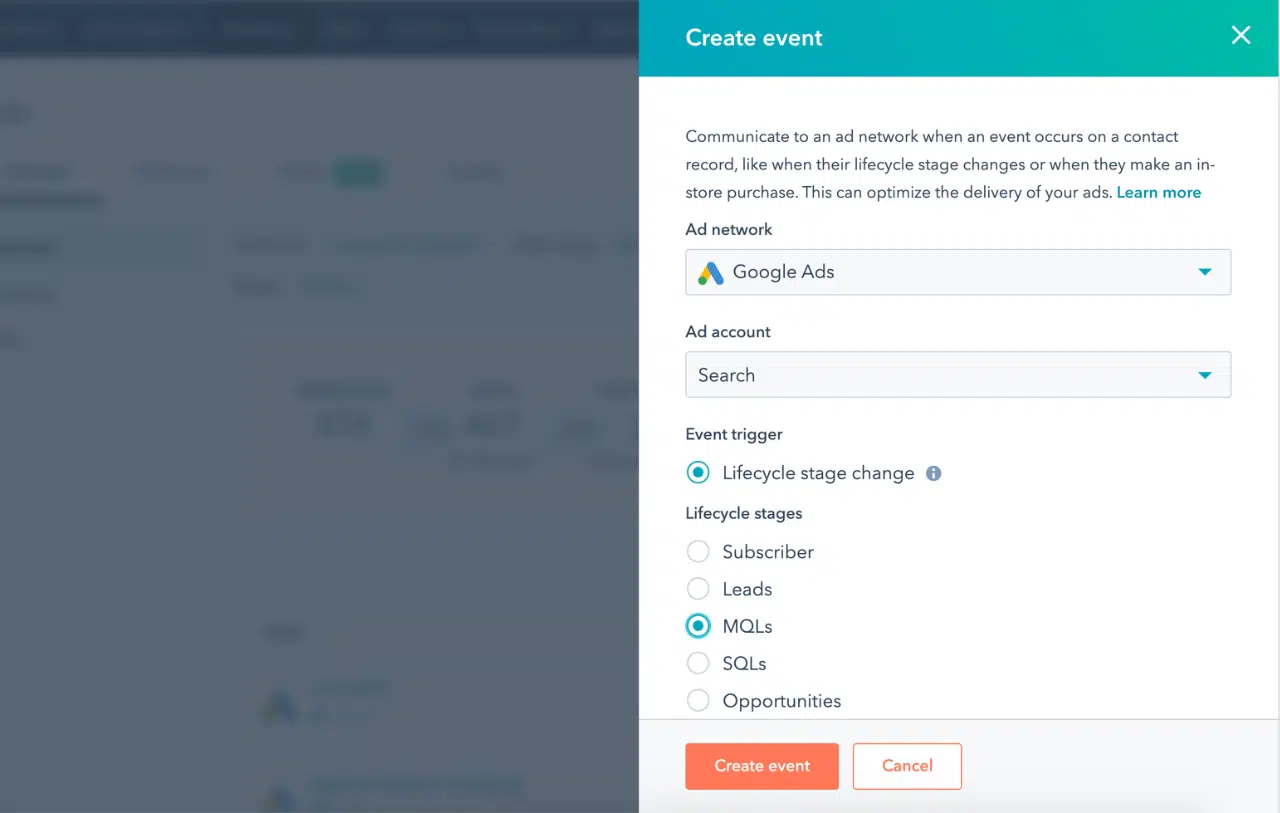
Offline Conversion Tracking with Zapier
In today’s digital age, advertising has become more complex than ever before. With the phasing out of third-party cookies, it has become increasingly difficult for companies to track conversions accurately. This has led to a shift towards first-party data and the need to track offline conversions. One powerful tool that can help with this is Zapier.
Offline conversion tracking refers to the process of tracking conversions that happen outside of the online realm. This includes in-store purchases, phone calls, and other offline actions.
However as we have discussed, in the context of online advertising, offline conversion tracking can also refer to situations where conversions occurred online but weren’t recorded by third-party cookies due to browser restrictions.
Zapier is a powerful tool that can help you track offline conversions and perform 1st party cookieless conversion tracking with your CRM or website. By automating workflows and transferring data between different systems, you can save time and ensure that your tracking is accurate. Zapier can connect with a wide range of CRM, websites, and other third-party systems like websites, making it easy to track offline conversions and synchronise your purchase funnel with ad platforms like Google Ads.
Recording Google Ads Offline Conversion Tracking with Zapier
To record Google Ads offline conversion tracking with Zapier, the first step is to set up an integration between your CRM or website and Google Ads. This integration allows you to track offline conversions by matching the click ID of the ad click to a conversion that occurs offline, such as a phone call or an in-store purchase.
Once the integration is set up, the next step is to map data fields between your CRM or website and Google Ads. This ensures that the data is transferred correctly and accurately tracked. You can then start recording offline conversions and track the effectiveness of your campaigns even if third-party cookies are blocked.
Cookieless Conversion Tracking with Your CRM or Website
Performing cookieless conversion tracking with Zapier involves collecting first-party data and setting up an integration between your CRM or website and Zapier. This integration allows you to transfer data between different systems and perform cookieless conversion tracking.
The first step in performing cookieless conversion tracking is to collect first-party data. This can be done through a variety of methods, including email sign-ups, customer surveys, and loyalty programs. By collecting first-party data, you can optimise your campaigns and improve your targeting.
Once you have collected first-party data, the next step is to set up an integration between your CRM or website and Zapier. This allows you to transfer data between different systems and perform cookieless conversion tracking.
You can then map data fields between your CRM or website and the ad platform you are using, ensuring that the data is transferred correctly and accurately tracked.
Finally, you can start recording conversions by matching the first-party data collected to conversions that occur online. We shall provide some example integration ideas that can be applied to different CRM scenarios later in this post.
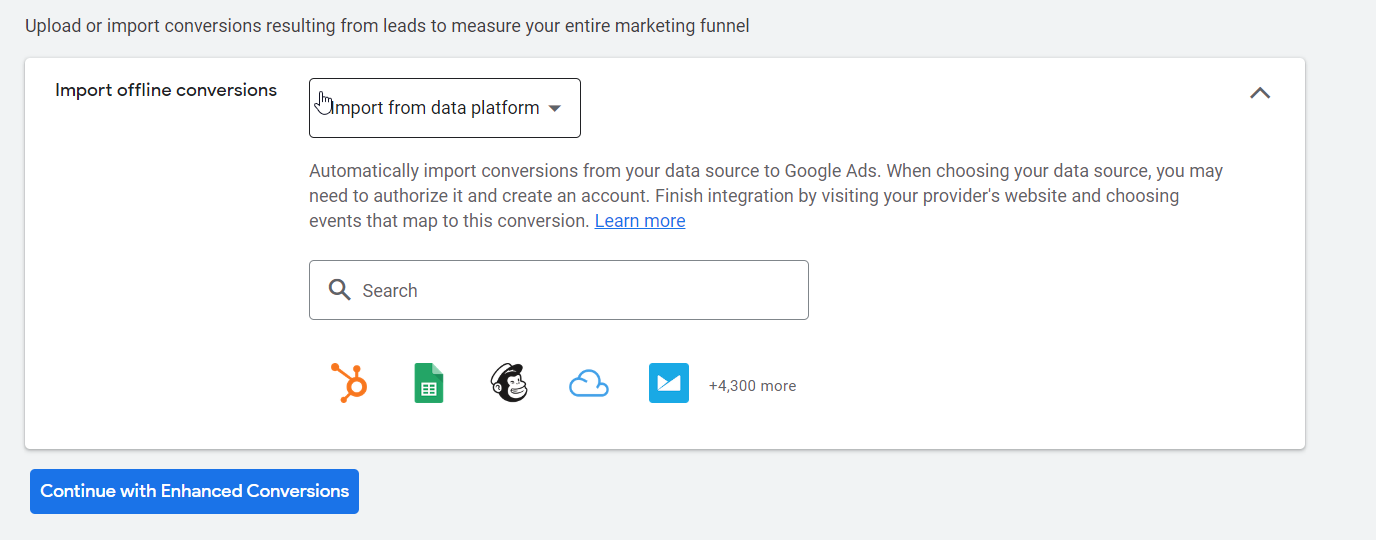
Benefits of Using Zapier for Offline Conversion Tracking
There are several benefits of using Zapier for offline conversion tracking, including:
1. Accurate Tracking:
By using Zapier to automate workflows and transfer data between different systems, you can ensure that your tracking is accurate.
2. Time-Saving:
By automating workflows and transferring data between different systems, you can save time and focus on other important aspects of your advertising campaigns.
3. Improved ROI:
By tracking offline conversions and performing cookieless conversion tracking, you can optimize your campaigns and improve your ROI.
4. Easy Integration:
Zapier can connect with a wide range of CRM, websites, and other third-party systems, making it easy to set up integrations and track offline conversions.
In conclusion, Zapier is a powerful tool that can help you track offline conversions and perform cookieless conversion tracking with your CRM or website. By automating workflows and transferring data between different systems, you can save time and ensure that your tracking is accurate. Whether you’re tracking offline
Zapier Google Ads Integration Checklist
I. Introduction
– Understand the challenges with tracking conversions accurately due to the phasing out of third-party cookies
– Learn The importance of offline conversion tracking in today’s digital age
– Introducing Zapier as a solution for offline conversion tracking in Google Ads
II. The Importance of First-Party Data
– Explanation of the importance of collecting first-party data and how it can help in tracking offline conversions
– Methods for collecting first-party data, such as email sign-ups, customer surveys, and loyalty programs, and how they can be used for advertising campaigns
– Benefits of using first-party data in advertising, such as better audience targeting and personalisation
III. Setting up Zapier Integration with Google Ads
– Overview of Zapier and how it integrates with Google Ads for offline conversion tracking
– Step-by-step guide to setting up the integration, including linking your CRM or website with Zapier and Google Ads
– Explanation of how Zapier automates workflows and transfers data between systems, ensuring accurate tracking
IV. Mapping Data Fields
– Explanation of how to map data fields between your CRM or website and Google Ads using Zapier
– Best practices for mapping data fields, including data consistency and accuracy
– The importance of accurate data mapping for successful offline conversion tracking, as it ensures that the data is transferred correctly and tracked accurately
V. Synchronising Purchase Funnel with Ad Platforms
– Explanation of how to use Zapier to synchronise your purchase funnel with Google Ads for offline conversion tracking
– Benefits of synchronising your purchase funnel with ad platforms, including improved ROI and campaign optimisation
– How to optimise your advertising campaigns using synchronised data and insights gathered from offline conversion tracking
VI. Conclusion
– Recap of the importance of tracking offline conversions in Google Ads and using first-party data in advertising campaigns
– Overview of how Zapier can help you track offline conversions and synchronise your purchase funnel with ad platforms
– Final thoughts and recommendations for successful offline conversion tracking, including the need for accurate data mapping and the use of first-party data.
By following the steps outlined in this blog post, you can start tracking offline conversions in Google Ads using Zapier. This will allow you to collect more first-party data and optimise your advertising campaigns. We hope that this blog post will be useful for you and your marketing team, and help you navigate the challenges of conversion tracking in a cookie-less world.
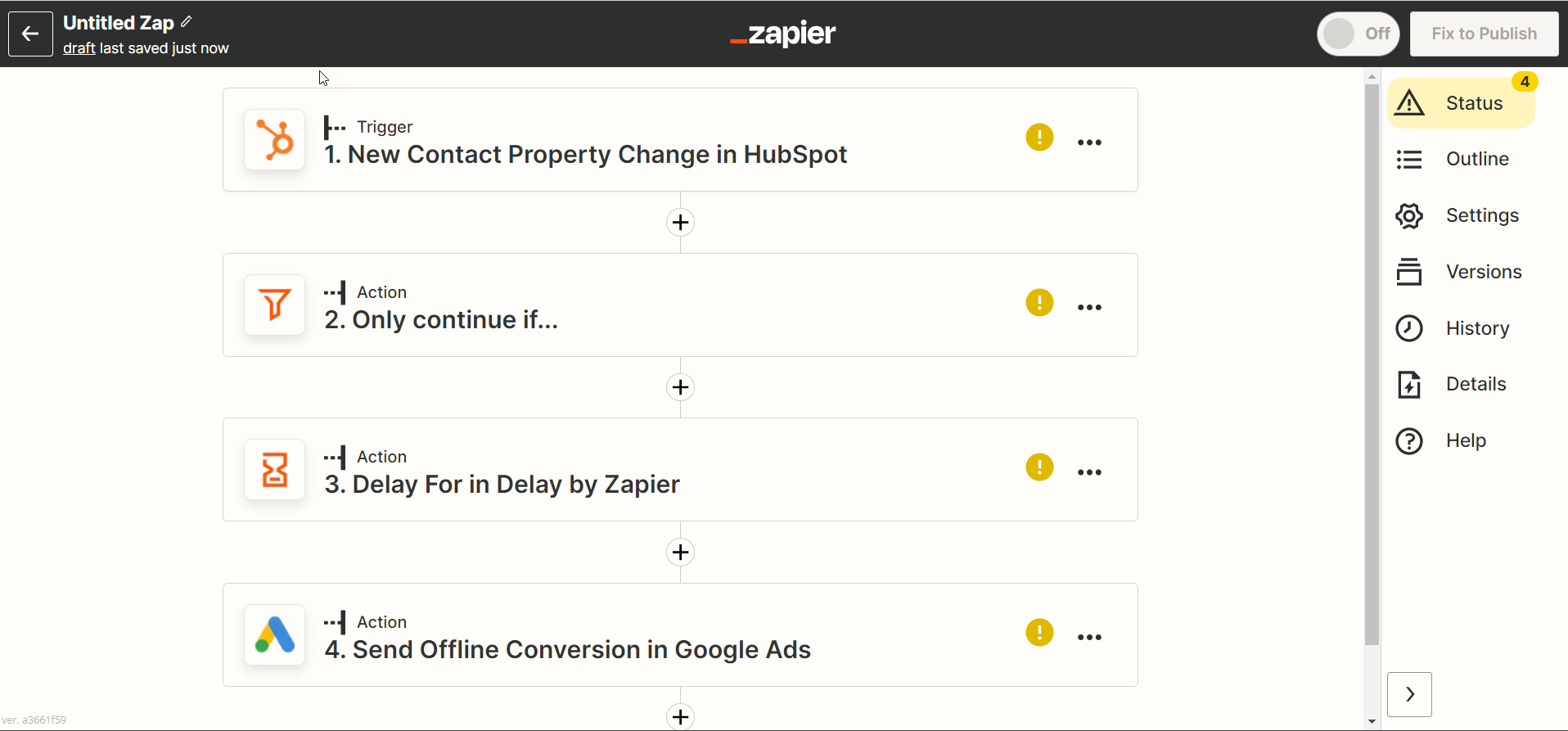
Using Zapier With HubSpot
If you are using HubSpot Marketing Starter edition, you do not have access to ad events which can be sent to HubSpot. In this case, you might want to use the integration offered by Zapier to sync your offline conversion data from HubSpot to Google Ads.. Even if you have access to HubSpot Marketing Hub Professional Edition, you may still prefer to use Zapier if you want to use a different trigger event to send conversions to Google Ads than the lifecycle stages offered by HubSpot.
While HubSpot Marketing Starter edition does not have ad events to sync with Google Ads, it still offers other features that can help you improve your reporting and conversion tracking. For example, both the Starter and free editions record a click ID that can be used to export offline conversions from a spreadsheet to Google Ads. However, building a “Zap” or workflow between HubSpot and Google Ads can streamline this process.
To set up HubSpot as the trigger app, you can use the event of a contact moving through your sales cycle or designated buyer funnel. This will allow you to track offline conversions and optimize your advertising campaigns.
In addition to tracking conversions, HubSpot also allows you to export your contact lists to Google Ads, Facebook Ads, and LinkedIn as customer match audiences or custom audiences, respectively. This can help you build targeted audiences on the ad platforms.
The integration with LinkedIn can even retarget past companies that visited your website by identifying their IP address. Then you can layer LinkedIn Ads job title targeting of decision makers!
HubSpot Ads also provides a single management console for all ad campaigns, allowing you to view consolidated reports and make changes more efficiently. By using Zapier to sync your conversion data with HubSpot, you can streamline your workflow and optimize your advertising campaigns.
